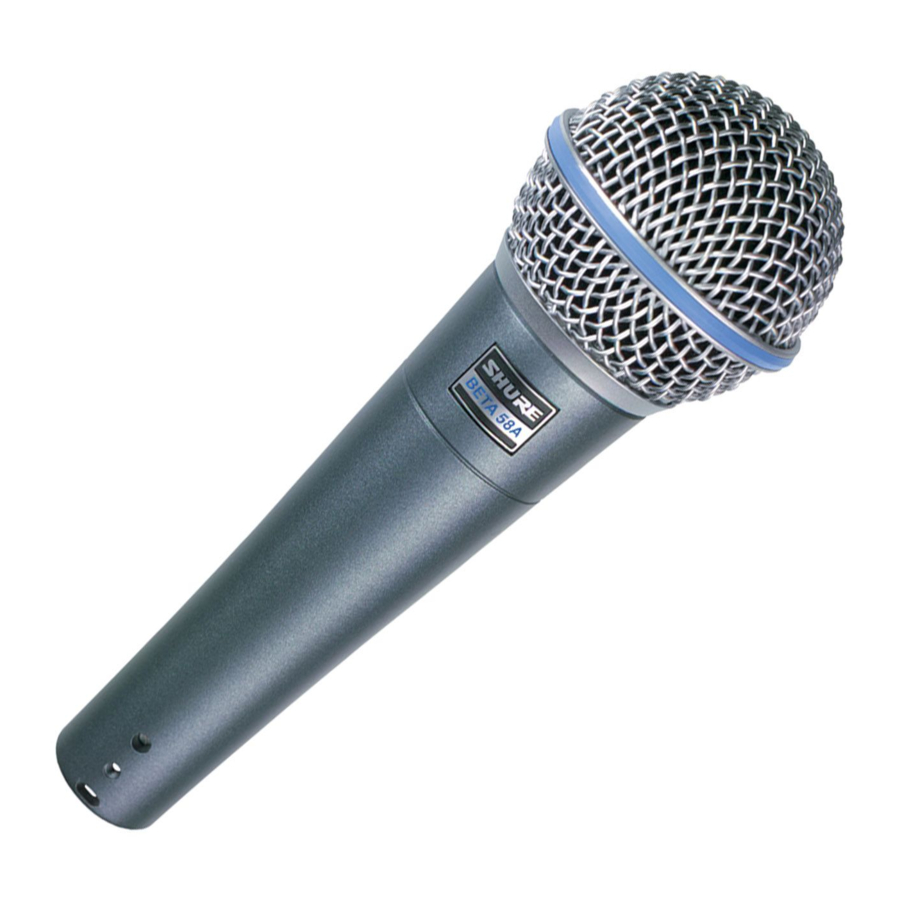Advertisement

GENERAL
The Shure BETA 58A is a high-output, supercardioid dynamic vocal microphone for professional sound reinforcement and project studio recording. It maintains a true supercardioid pattern throughout its frequency range. This ensures high gain before feedback, maximum isolation from other sound sources, and minimum offaxis tone coloration.
The BETA 58A has a shaped frequency response that is ideal for close-up vocals. The superb performance of this microphone is not affected by rough handling because of its rugged construction, proven shock mount system, and hardened steel mesh grille. Typical applications for the BETA 58A include lead vocals, backup vocals and speech.
FEATURES
- Frequency response tailored for vocals, with brightened midrange and bass rolloff to control proximity effect
- Uniform supercardioid pattern for high gain before feedback and superior rejection of off-axis sound
- Neodymium magnet for high signal-to-noise output
- Hardened steel mesh grille that resists wear and abuse
- Advanced pneumatic shock mount system that minimizes transmission of mechanical noise and vibration
- Minimally affected by varying load impedance
- Legendary Shure quality and reliability
APPLICATION AND PLACEMENT
The BETA 58A is designed for close-up vocals, and can be hand held or mounted on a stand. Some of the most common applications and placement techniques are listed in the following table. Keep in mind that microphone technique is largely a matter of personal taste; there is no one "correct" microphone position.
| SUGGESTED MICROPHONE PLACEMENT | TONE QUALITY |
| Lips less than 15 cm (6 in.) away or touching the windscreen, on axis to microphone. | Robust sound, emphasized bass, maximum isolation from other sources. |
| 15 to 60 cm (6 in. to 2 ft.) away from mouth, just above nose height. | Natural sound, reduced bass. |
| 20 to 60 cm (8 in. to 2 ft.) away from mouth, slightly off to one side. | Natural sound, reduced bass and minimal "s" sounds. |
| 90 cm to 1.8 m (3 to 6 ft.) away. | Thinner, distant sound; noticeable levels of ambient noise. |
GENERAL RULES FOR MICROPHONE USE
- Aim the microphone toward the desired sound source and away from unwanted sources. Since supercardioid microphones such as the BETA 58A have narrow pickup patterns and can pick up sounds from the rear, this may not be obvious or intuitive.
- Place the microphone as close as practical to the desired sound source. Refer to the table above.
- Work close to the microphone for extra bass response.
- Use only one microphone to pick up one sound source.
- Keep the distance between microphones at least three times the distance from each source to its microphone.
- Use the fewest number of microphones as is practical.
- Place microphones as far as possible from reflective surfaces.
- Add a windscreen when using the microphone outdoors.
- Avoid excessive handling to minimize pickup of mechanical noise and vibration.
- Do not cover any part of the grille with your hand.
PROXIMITY EFFECT
Unidirectional microphones such as the BETA 58A progressively boost bass frequencies by 6 to 10 dB at 100 Hz when the microphone is at a distance of about 6 mm (1/4 in.) from the sound source. This phenomenon, known as proximity effect, can be used to create a warmer, more powerful sound. To prevent explosive low frequency sound during close-up use, the BETA 58A bass response gradually rolls off. This provides greater control and helps the user take advantage of proximity effect.
STAGE MONITOR & P.A. LOUDSPEAKER PLACEMENT
For maximum rejection of unwanted sound, place the stage monitor(s) or P.A. system loudspeaker at a 60° angle from the rear of the BETA 58A, not directly behind it. Always check out the stage setup before a performance to ensure that microphone and monitor placement is optimum.

RECOMMENDED LOUDSPEAKER LOCATIONS
SPECIFICATIONS
Type
Dynamic (moving coil)
Frequency Response
50 to 16,000 Hz


TYPICAL FREQUENCY RESPONSE
Polar Pattern
Supercardioid, rotationally symmetrical about microphone axis, uniform with frequency

TYPICAL POLAR PATTERNS
Output Level (at 1,000 Hz)
Open Circuit Voltage: -51.5 dBV/Pa* (2.6 mV)
*1 Pa = 94 dB SPL
Impedance
Rated impedance is 150 Ω (290 Ω actual) for connection to microphone inputs rated low Z
Phasing
Positive pressure on diaphragm produces positive voltage on pin 2 with respect to pin 3

INTERNAL WIRING
Case
Silver blue enamel-painted die cast metal with hardened, mattefinished, spherical steel mesh grille
Adjustable, Stand Adapter
Slip-in microphone mounting, unbreakable, adjustable through 180° with standard 5/8"-27 thread, black finish
Dimensions

OVERALL DIMENSIONS
Net Weight
278 grams (9.92 oz)
FURNISHED ACCESSORIES
Adjustable Stand Adapter: A25D
5/8" to 3/8" (Euro) Thread Adapter: 95A2050
Storage Bag: 26A21
OPTIONAL ACCESSORIES
Windscreen: A58WS Series (8 colors available)
Isolation Mount: .A55M, A55HM
7.6 m (25 ft.) Cable: C25E, C25F
REPLACEMENT PARTS
Cartridge: R176
Grille Assembly: RK265G
Plug (Connector) Assembly: 90F1984
SHURE Incorporated http://www.shure.com United States, Canada, Latin America, Caribbean:
5800 W. Touhy Avenue, Niles, IL 60714-4608, U.S.A. Phone: 847-600-2000 U.S. Fax: 847-600-1212 Intl Fax: 847-600-6446
Europe, Middle East, Africa:
Shure Europe GmbH, Phone: 49-7131-72140 Fax: 49-7131-721414
Asia, Pacific:
Shure Asia Limited, Phone: 852-2893-4290 Fax: 852-2893-4055

Documents / Resources
References
Download manual
Here you can download full pdf version of manual, it may contain additional safety instructions, warranty information, FCC rules, etc.
Advertisement
Thank you! Your question has been received!




















Need Assistance?
Do you have a question about the BETA58A that isn't answered in the manual? Leave your question here.